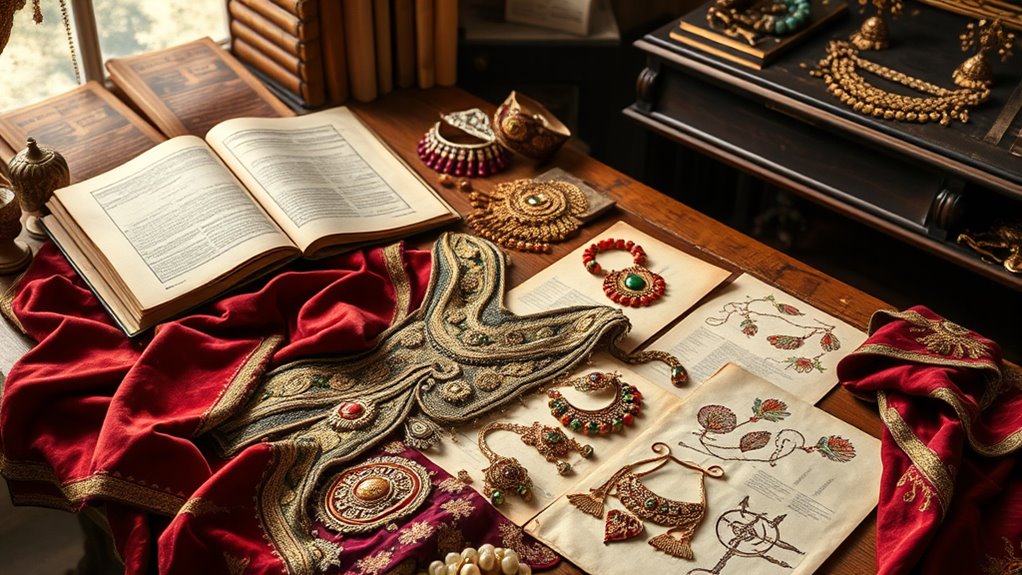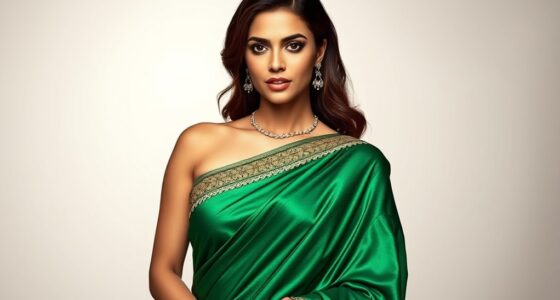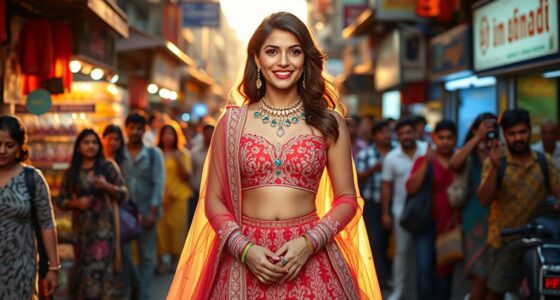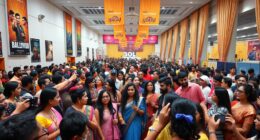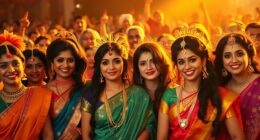To research period films like “Padmaavat,” you explore historical texts, artwork, and artifacts to understand authentic clothing, fabrics, and accessories. You study details like garment cuts, embroidery, and color palettes to guarantee accuracy. It’s important to contemplate cultural influences, customs, and regional styles to create believable costumes. Using visual references from paintings, sculptures, and museums helps refine details. Keep exploring how these elements come together, and you’ll uncover the secrets behind stunning costume design.
Key Takeaways
- Study historical texts, paintings, and artifacts to understand authentic clothing styles, fabrics, and accessories from the era.
- Explore cultural customs, regional textile traditions, and symbolism to accurately reflect social hierarchies and regional influences.
- Use visual references like sculptures and museum archives to inform details and craftsmanship of period costumes.
- Consider practicality and movement of garments to ensure costumes are both authentic and actor-friendly.
- Balance historical accuracy with cultural significance, integrating traditions and storytelling to enhance immersion.
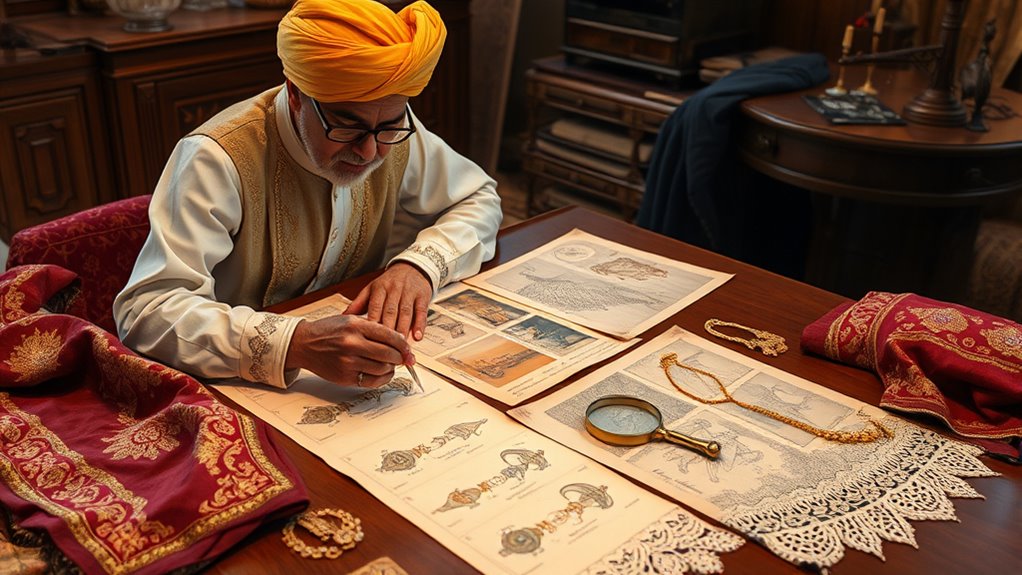
Creating a convincing period film like “Padmaavat” requires thorough research and attention to detail. As a costume designer, your goal is to guarantee that every piece you create accurately reflects the era, blending historical accuracy with authentic cultural influences. To achieve this, you need to dive deep into the history and traditions of the time period you’re depicting. Start by studying historical texts, paintings, and artifacts from the era to understand how people dressed, the fabrics they used, and the accessories they favored. It’s essential to stay true to the specific time frame, paying close attention to details like the cut of garments, embroidery styles, and color palettes that were prevalent. These elements help lend credibility and immersive authenticity to the film.
Thorough research and attention to detail ensure authentic, immersive period costumes in “Padmaavat.”
Cultural influences play a fundamental role in shaping the costumes. You’ll want to explore the customs, social hierarchies, and regional styles that influenced fashion during that period. For “Padmaavat,” this means understanding the intricate courtly attire of Rajput royalty, the regional textile traditions, and the symbolism behind certain colors and motifs. You might consult historical experts or cultural scholars to gain insights into the nuances of traditional dress, guaranteeing that the costumes reflect the diverse influences that shaped the era. Incorporating these cultural elements isn’t just about aesthetics; it’s about telling a story that respects the traditions and identities of the characters and their communities.
In your research, don’t rely solely on written sources. Visual references like paintings, sculptures, and surviving garments are invaluable for capturing the texture and detail of period clothing. Museums and archives can provide access to authentic textiles or replicas, giving you a tactile sense of materials and craftsmanship. Additionally, consider the practical aspects—how people wore and moved in these garments. This helps you create costumes that aren’t just visually accurate but also functional for the actors. Studying historical textiles can provide deeper insights into fabric construction and dyeing techniques, elevating the authenticity of your costumes. The goal is to craft costumes that resonate with viewers on a cultural level, evoking a sense of time and place that feels genuine and respectful.
Ultimately, your work as a costume designer hinges on balancing historical accuracy with cultural influences. When you do this thoughtfully, your costumes won’t just look beautiful—they’ll serve as a essential storytelling element, immersing audiences in the richness of the period depicted in “Padmaavat.”
Frequently Asked Questions
How Do Costume Designers Balance Historical Accuracy With Creative Interpretation?
You balance cultural authenticity with creative liberty by thoroughly researching historical details, ensuring costumes reflect the period accurately. At the same time, you incorporate artistic elements to enhance storytelling and visual appeal. This blend allows you to respect cultural nuances while also adding your creative touch. You prioritize authenticity where it matters most, but confidently adapt designs to serve the film’s aesthetic and narrative, creating a compelling and respectful portrayal.
What Role Do Fabric Specialists Play in Period Film Costume Research?
You rely on fabric specialists to deepen your understanding of textile techniques and dyeing processes essential for period film costumes. They analyze historical fabrics, helping you select authentic materials and colors. Their expertise guarantees your costumes reflect the era’s craftsmanship, blending accuracy with creativity. By collaborating with these specialists, you can achieve a visually compelling and historically grounded look that enhances the film’s authenticity and storytelling.
How Do Designers Incorporate Cultural Symbolism Into Costumes?
You incorporate cultural symbolism into costumes by weaving cultural motifs and symbolic embroidery that reflect the characters’ identities and societal values. These details add layers of meaning, resonating with the audience’s understanding of tradition and history. You carefully select patterns, colors, and embellishments that serve as visual metaphors—like royal insignias or spiritual symbols—enhancing storytelling and deepening viewers’ connection with the film’s cultural context.
What Challenges Arise When Sourcing Authentic Materials for Period Costumes?
When sourcing authentic materials for period costumes, you face challenges like limited availability and guaranteeing authentic craftsmanship. You need to find genuine fabrics and accessories that match the era, which often involves extensive material sourcing. This process requires patience, research, and sometimes custom orders to maintain historical accuracy. By prioritizing authentic craftsmanship, you ensure your costumes are true to the period, but it can be time-consuming and costly.
How Do Costume Designers Collaborate With Directors on Historical Storytelling?
You collaborate closely with directors to guarantee your costumes support the story’s historical authenticity and cultural depth. By sharing insights into fashion history, you align your designs with the director’s vision, blending accuracy with creative expression. Regular discussions help you interpret cultural details accurately, ensuring costumes enhance storytelling while respecting cultural authenticity. This teamwork results in visually stunning, authentic period costumes that bring the film’s historical world vividly to life.
Conclusion
Your dedication to research turns history into a vivid tapestry, bringing period films like “Padmaavat” to life. Every detail you uncover acts as a brushstroke, painting authenticity into the fabric of the story. When you immerse yourself fully, you become the bridge between past and present, making history breathe anew. Like a master weaver, your work threads together research and creativity, transforming costumes into powerful storytellers that captivate and educate audiences alike.
